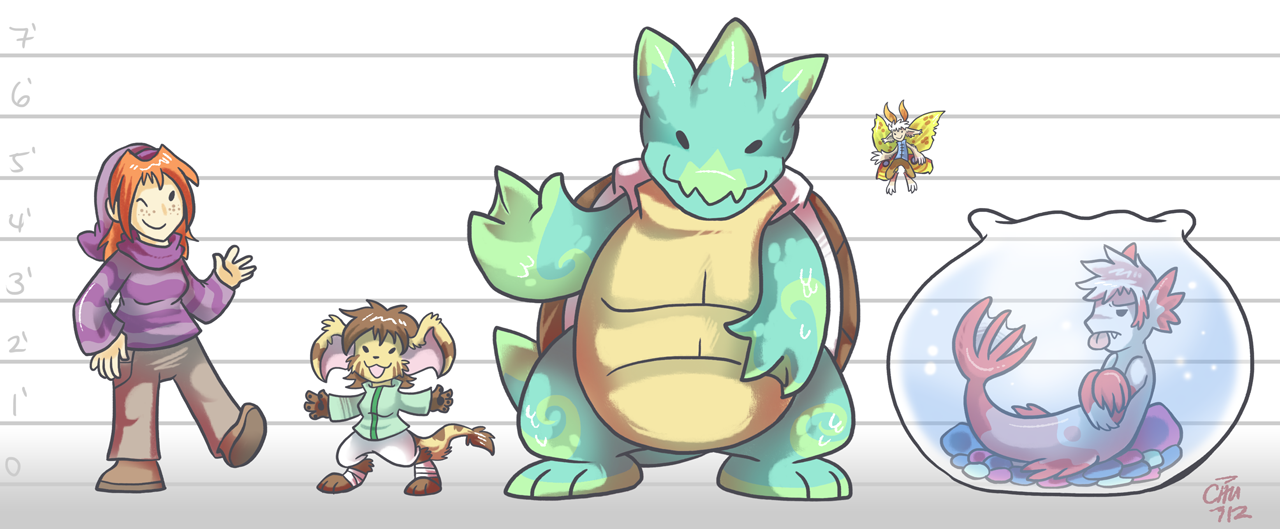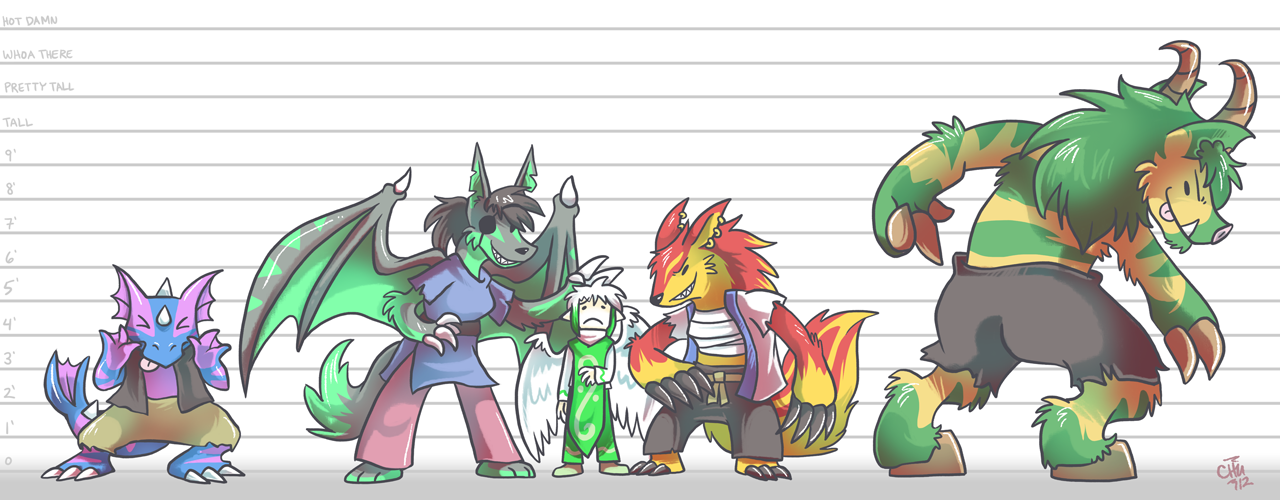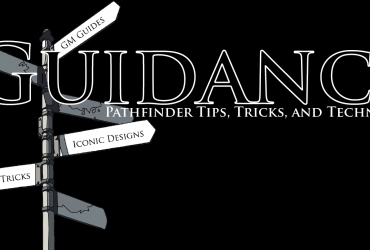Welcome to Guidance, Private Sanctuary’s source for tips and techniques for the Pathfinder Roleplaying Game, written by Everyman Gamer Alexander Augunas. Today, we’re going to be talking about the webcomic Slightly Damned. Its creator, who goes by the pen name Chu, was gracious enough to allow us to post some character artwork from Slightly Damned on today’s blog. You should thank her in kind by following this link to her website and start reading the webcomic. Now.
Another week, another topic for the Algalon Paradigm! This week we’re looking at another webcomic: this time, it’s Slightly Damned by Chu.
Slightly Persistent
So, before we get started I’ll mention a little more about Slightly Damned’s author. Chu is the author’s penname. She doesn’t often make her real name public, so I’m going to respect her right to privacy and use her penname throughout this article. Chu’s a mostly self-taught cartoonist who recently finished her first semester at cartooning college. Yes, that’s apparently a thing so congratulations, Chu!
Moving on to her webcomic, Chu started Slightly Damned in 2004, so the webcomic just celebrated its ten-year anniversary. Slightly Damned is set in the fictitious world of Medius and centers around a trio of friends who are introduced as the comic wears onward: Buwario, Rhea, and Kieri.
Slightly Unique

From left to right: humans, jakkai, khamega, fairy, and merfolk. Yes, Median’s races are as colorful as they are distinct.
So, time to talk about the first aspect of Slightly Damned that makes it an interesting read: the races. Chu has managed to create a handful of colorful races in her world, and honestly most of them haven’t been touched upon yet. Her world’s races are as follows:
- Humans: Nothing new to see here. Moving on.
- Jakkai: They’re sort of like furry halflings that lay eggs and have ridiculously strong tails. They’re a subversion of the usual “small is weak” trope that you see in Pathfinder: aside from the Khamegas, the Jakkai are reportedly one of the most physically strong races in the setting.
- Fairies: One of Slightly Damned’s major races are fey creatures. They’re Tinkerbell-sized creatures with powerful magic.
- Khamegas: Imagine a race of peaceful, hippie Bowsers (from Mario). That’s Khamegas in a nutshell. Despite most khamegas being peaceful, they’re the most physically imposing races: in Pathfinder terms, they’re probably Large.
- Merfolk: Pretty much the same as Pathfinder.
- Mixlings: For the most part, many of the aforementioned races can crossbread into mixlings (also called Bitza). The resulting offspring have obvious patterns and parts from their parent races. The mother’s race seems to determine the “template” for the creature whilst the father adds “cosmetic traits.” Naming conventions for the races follow real-world hybrid rules: human mother-jakkai father is a hukai while a jakkai mother-human father could very well be a jakman. These mixed children are fairly uncommon and tend to exist solely in cities where races mingle.
- Angels & Demons: These “outsiders” are from Heaven and Hell respectfully. Angels are all fairly standard in appearance: beautiful humanoids with fair skin and white hair while demons range vastly based on their elements. We’ll get to the elemental stuff in a minute, though.
Talking about races, the focus of the story is on a jakkai, an angel, and a demon. It isn’t until deep in the book when human characters start becoming prevalent, so the distinctly non-humanocentrism of Slightly Damned is very refreshing compared to “traditional” Roleplaying settings.
Slightly Extraplanar
Another interesting aspect of Slightly Damned is how it handles its extraplanar storytelling. Unlike many roleplaying games, which use planar adventures as high-level content, Slightly Damned begins its story in Hell. As the comic’s tagline states, Rhea dies in the first comic and that’s where the story begins. Its pretty ballsy compared to many of the other stories we see out there.
More importantly, Slightly Damned’s take on planar affairs is very interesting. The entire story becomes built upon the shoulders of three cosmic entities: Gaia, Mother of Heaven; Syndel, Ruler of Hell; and Death. In the beginning, Gaia creates Heaven, Syndel creates Hell, and Death convinced both to work together to create Medius, the land of mortals. After its creation, the gods agreed to never directly interfere in Medius and instead divided up mortal souls after their passing: Gaia takes righteous souls into Heaven, Syndel torments evil souls in Hell, and Death brings the rest into Purgatory. Things worked out well until the Great War between Gaia and Syndel, which takes place on Medius. The war reportedly ended in a ceasefire 200 years before the comic starts.
In addition to these three gods, there are 12 “Guardians” of the Medius, each embodying an elemental aspect. For example, there are three fire guardians, three water guardians, three air guardians, and three earth guardians. The Guardians are something akin to demigods; they have phenomenal cosmic power, can shapeshift into mortal form, and are able to be outright killed. In its true form, each Guardian is one of a specific kind of animal relating to its element.
Despite all of this, religion doesn’t seem to be a big thing in Medius. When angels and demons walk among you, there isn’t much need for worship I suppose. The cosmic entities judge people based upon the life they lead, not how much they revere Gaia, Syndel, or Death. In short, Slightly Damned has an interesting cosmology that proves you don’t need a baker’s dozen of deities to make an interesting religious framework (though we never see any churches or temples in Medius).
Slightly Elemental
The final (neat) element of Slightly Damned is its elemental alignments. All living creatures are aligned with one of the classic elements: air, earth, fire, or water. This determines the type of magic they can wield and is either hereditary or based upon the individual’s proximity to a guardian. For example, Rhea grew up in a village that was overseen by an earth guardian and she can use earth magic somewhat shakily. Here’s a quick run-down:
- Humans: They are the ‘Marios’ of magic; they’re not the most powerful magic users but their widespread and populous numbers means that magic users of all elements exist among them. Thus far, we’ve seen a fire magic human and that’s about it.
- Jakkai: Both of the magic using jakkai that we’ve seen in Slightly Damned used earth magic. According to the jakkai, their race is the least proficient in magic of all five mortal races.
- Fairies: They’re reportedly the most magical of the races. We’ve seen air using fairies, but one fairy is able to use his magic in conjunction with a human to perform fire magic. The jury’s out on this one, but they’re likely just as versatile as humans at magic.
- Khamegas: Unknown, but water is a safe-bet. Its also a safe bet that they’re probably worse than humans, but better than jakkai at magic.
- Merfolk: Unknown, but as with khamegas water is a safe-bet. They’re probably better than humans, but worse than fairies.
- Angels: Angels are born into families that are aligned with one of the four elements. They dye their white hair to match the element’s aura (red for fire, green for air, yellow for earth, or blue for water) and wear heraldry that matches their element. Angels are considered innately magical as a result of this prowess and have a degree of resistance against some types of magic.
- Demons: Of all the races in Slightly Damned, element impacts demons the most. In truth, the word ‘demon’ is less of a race and more of a category for four separate demonic races, because demons of varying elements look extremely different from one another. Fire demons are lithe and crazed, air demons have massive, bat-like wings, earth demons are huge and imposing, and so on. Demons are considered innately magical as a result of this and have a degree of resistance against some types of magic.
Slightly Applicable to Pathfinder

This is more akin to what Chu’s art style looks like in comic form. Here we see the three main characters, plus the shadow of Death.
So now that I’ve talked about the comic, here are some good lessons that can be applied to your Pathfinder games from Slightly Damned:
- You can run effective extraplanar games at low-levels. Using a weird plane as your starting point offers an interesting contrast between the “real world” and makes your heroes seem more epic for their time spent in the realms beyond.
- You don’t need a deific cast of thousands to tell an interesting story. Sometimes having one or two major divine players is more than enough.
- Even if your heroes aren’t powerful enough to take on a specific challenge, showing your players sometime cool that happens is always better than telling them about it from afar.
- Killing something big and friendly towards you is a great way to get players invested in your world.
- For humanocentrism to be effective, it needs to be contrasted by the clearly not-human on a regular basis. If everything is human all the time, then why not set your games on an alternate reality Earth instead?
And that about wraps up my thoughts on Slightly Danbed for this installment of the Algalon Paradigm. What do you think? What’s the earliest level that you’ve ever run an extraplanar adventure? When’s the most effective time to use extraplanar content? How many deities do you typically involve in your storylines? Leave your answers and comments below, and I’ll see you next week!
Alexander “Alex” Augunas has been playing roleplaying games since 2007, which isn’t nearly as long as 90% of his colleagues. Alexander is an active freelancer for the Pathfinder Roleplaying Game and is best known as the author of the Pact Magic Unbound series by Radiance House. Alex is the owner of Everyman Gaming, LLC and is often stylized as the Everyman Gamer in honor of Guidance’s original home. Alex’s favorite color is blue, his favorite Pathfinder Race/Class combination is kitsune guardian, and his joke isn’t funny this time. Sorry.







Leave a Reply